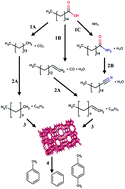The effect of temperature, heating rate, and ZSM-5 catalyst on the product selectivity of the fast pyrolysis of spent coffee grounds†
Abstract
Spent coffee grounds (SCG) are a continuously produced and abundant biomass resource that is rich in fixed carbon and underutilized. In this study, fast pyrolysis was employed as a method of upgrading this waste product into higher value chemicals and commodities. The effect of catalytic upgrading via a ZSM-5 catalyst on the pyrolysis product was investigated at two heating rates and three different pyrolysis temperatures. The ZSM-5 catalyst was explored as the means to increase the selectivity to deoxygenated olefins and aromatic products. The liquid products from the pyrolysis of SCG were predominantly fatty acids, linear hydrocarbons, furans, phenols, ketones, and aromatic hydrocarbons. The ZSM-5 catalyst was seen to decrease selectivity to linear hydrocarbons and furans, and enhance selectivity to aromatic hydrocarbons and CO. Increasing the pyrolysis temperature was seen to decrease selectivity to fatty acids, and increase selectivity to aromatic and linear hydrocarbons.


 Please wait while we load your content...
Please wait while we load your content...